STOMP User Guide
STOMP User Guide
Aqueous Relative Permeability Card Options
The aqueous relative permeability functions relate phase saturations with aqueous relative permeability. The Mualem and Burdine aqueous relative permeability functions are also dependent on the saturation function type and are strictly applicable to the van Genuchten (1980) and Brooks and Corey (1966) functions. For these functions, either the van Genuchten ‘m’ parameter or the Brooks and Corey ‘λ’ parameter can be defaulted to the values entered or defaulted with the saturation function. Functional forms for the aqueous relative permeability-saturation functions are preferred, but tabular input is acceptable. By default, tabular data will be interpolated using linear interpolation, whereas values beyond the table limits will be assigned either the table minimum or maximum values appropriately. The following relative permeability models can be specified in the Aqueous Relative Permeability Card. A model must be specified for each rock type defined in the Rock/Soil Zonation Card. The models and sub-options available are described under the correponding tab.
- Effective Saturations
- Burdine
- Mualem
- Fatt and Klikoff
- Corey
- Haverkamp
- Touma and Vauclin
- Constant
- Tabular
- Fractured Media
Effective Saturations
Mobile saturations are scaled by the residual aqueous liquid saturation to determine effective saturations for use with common relative permeability models.
The effective aqueous liquid saturation:

The effective aqueous nonaqueous liquid saturation:

The effective gas saturation:

The wetting phases are combined for a total effective liquid saturation:

| Symbols | |
 |
effective aqueous liquid saturation |
 |
actual aqueous liquid saturation |
 |
actual aqueous liquid residual saturation |
Burdine
The Burdine (1953) relative permeability function is described as

Aqueous phase relative permeability can be computed as a function of aqueous saturation from knowledge of the soil-moisture retention function and the pore distribution model of Burdine [1953]. If the van Genuchten and Brooks and Corey soil-moisture retention functions are used, closed-form expressions for fluid phase relative permeability can be derived. Using the van Genuchten soil-moisture retention function, the aqueous phase relative permeability appears as shown:

Using the Brooks and Corey soil-moisture retention function, the aqueous phase relative permeability appears as shown:

| Symbols | |
 |
aqueous relative permeability |
 |
effective aqueous liquid saturation |
 |
van Genuchten m parameter |
 |
Brooks and Corey parameter |
 |
capillary head, m |
Mualem
The Mualem(1976) relative permeability function is described as

where L = 0.5.
Aqueous phase relative permeability can be computed as a function of aqueous saturation from knowledge of the soil-moisture retention function and the pore distribution model of Mualem [1976]. If the van Genuchten and Brooks and Corey soil-moisture retention functions are used, closed-form expressions for fluid phase relative permeability can be derived. Using the van Genuchten soil-moisture retention function, the aqueous relative permeability appears as shown:

Using the Brooks and Corey soil-moisture retention function, the aqueous phase relative permeability appears as shown:

| Symbols | |
 |
aqueous relative permeability |
 |
effective aqueous liquid saturation |
 |
van Genuchten m parameter |
 |
Brooks and Corey parameter |
 |
capillary head, m |
Modified Mualem
Irreducible Mualem
Mulaem with Polman
The Mualem (1976) relative permeability model is used to calculate the vertical permeability and the Polmann (1990) model is used to calculate horizontal permeability.
Polmann (1990) used a stochastic model to evaluate tension-dependent anisotropy. The Gardner (1958) relationship was used to describe unsaturated hydraulic conductivity as a function of saturated hydraulic conductivity and tension. Using a linear correlation model between the zero-tension intercept and β, Polmann (1990) presented a generalized model that accounts for the cross-correlation of the local soil property (i.e., lnKs and β) residual fluctuations. Compared against the uncorrelated lnKs and β model, the partial correlation of the properties was shown to have a significant impact on the magnitude of the effective parameters derived from the stochastic theory. The Polmann (1990) equations for deriving the effective parameters for strongly stratified porous media are as shown below.
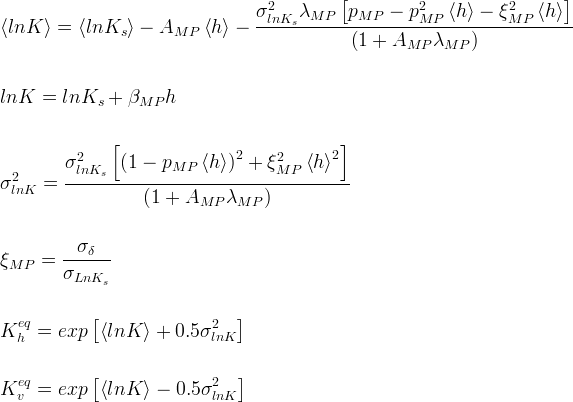
A modified version of the original Polmann model is implemented in STOMP. This version uses a single segment of the log-linear K(h) function. Because the Polmann model is based on the log-linear hydraulic function, it may be applicable only to a relatively narrow pressure head range over which the parameters are derived. Extrapolating the derived hydraulic function to other pressure head conditions may cause significant error or even physically incorrect results (e.g., the predicted hydraulic conductivity in the horizontal direction may increase with decreasing saturation, which is physically incorrect). It calculates an anisotropy coefficient (Can) and the hydraulic conductivity in the horizontal direction (Kh). The modified model also requires user specified maximum (Canmax) and minimum (Canmin) limits of the anisotropy coefficient. If computed values of Can are outside these limits, the values are truncated as shown in the equations below:
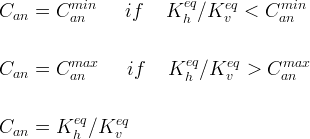
| Symbols | |
 |
equivalent unsaturated hydraulic conductivity in the horizontal direction, m/s |
 |
equivalent unsaturated hydraulic conductivity in the vertical direction, m/s |
 |
unsaturated hydraulic conductivity (pressure dependent), m/s |
 |
saturated hydraulic conductivity, m/s |
 |
mean of LnKs |
 |
capillary head, m |
 |
standard deviation of the residuals in the LnKs vs. β regression for all the samples considered |
 |
standard deviation of LnKs |
 |
variance of LnKs |
 |
slope between LnKs and h |
 |
slope of LnKs vs. β regression line for the samples considered |
 |
mean slope of β for LnK vs. h regression |
 |
vertical correlation length for LnKs |
 |
anisotropy coefficient |
 |
maximum value of anisotropy coefficient |
 |
minimum value of anisotropy coefficient |
Brooks, RH and AT Corey. 1966. "Hydraulic Properties of Porous Media Affecting Fluid Flow," Proc. ASCE J. Irrig. Drain. Div. , 92:61-68.
Mualem, Y. 1976. "A New Model for Predicting the Hydraulic Conductivity of Unsaturated Porous Media," Water Resources Research, 12:513-522.
van Genuchten, MT. 1980. "A Closed-Form Equation for Predicting the Hydraulic Conductivity of Unsaturated Soils," Soil Science Society of America Journal, 44:892-898.
Fatt and Klikoff
Aqueous- and gas-phase relative permeability are computed according to the Fatt and Klikoff [1959] models from the conventionally defined effective aqueous saturation according to equations (1) and (2), respectively.

| Symbols | |
 |
aqueous relative permeability |
 |
gas relative permeability |
 |
effective aqueous liquid saturation |
Corey Model
Aqueous- and gas-phase relative permeability can be computed from modified expressions for effective aqueous saturation according to the empirical model of Corey [1977]. The model of Corey accounts for trapped air through a modification to the definition of the effective aqueous saturation according to equation (1). The Corey functions for aqueous- and gas-phase relative permeability are computed according to equations (2) and (3), respectively.
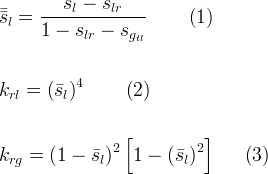
| Symbols | ||
 |
aqueous relative permeability | |
 |
gas relative permeability | |
 |
effective aqueous liquid saturation | |
 |
apparent aqueous liquid saturation | |
 |
actual aqueous liquid saturation | |
 |
actual aqueous liquid residual saturation | |
 |
actual gas saturation trapped by aqueous phase | |
Free Corey
The free Corey is a modified version of the empirical model of Corey [1977]. The model accounts for trapped air through a modification to the definition of the effective aqueous saturation according to equation (1). The free Corey function for aqueous-phase relative permeability is computed according to equation (2).
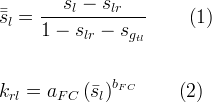
| Symbols | ||
 |
apparent aqueous liquid saturation | |
 |
effective aqueous liquid saturation | |
 |
actual aqueous liquid saturation | |
 |
actual aqueous liquid residual saturation | |
 |
actual gas saturation trapped by aqueous phase | |
 |
aqueous relative permeability | |
 |
Free Corey model parameter | |
 |
Free Corey model parameter | |
Haverkamp

| Symbols | ||
 |
aqueous relative permeability | |
 |
capillary head, m | |
 |
Haverkamp function parameter | |
 |
Haverkamp function parameter | |
Touma and Vauclin

| Symbols | ||
 |
aqueous relative permeability | |
 |
effective aqueous liquid saturation | |
 |
Touma and Vauclin function parameter | |
 |
Touma and Vauclin function parameter | |
Constant
The relative permeability is constant regardless of saturation.
Tabular
This option accepts tabulated relative permeability data. The default is the data of aqueous saturation and aqueous relative permeability data pairs and linear interpolation is used between data points; a cubic spline interpolation scheme can also be specified. Alternately, capillary head vs relative permeability can be provided using the keyword "head." Other interpolation schemes that can be specified for capillary head vs. aqueous relative permeability are log capillary head vs relative permeability, cubic spline, or cubic spline for log capillary head vs relative permeability.
Fractured Media
Dual porosity functions or equivalent continuum models [Klavetter and Peters 1986; Nitao 1988] relate bulk fluid phase relative permeabilities to those for the fracture and matrix according to equations (1) and (2). Dual porosity models require the assumption that fracture and matrix fluid pressures are in equilibrium, which inherently neglects transient fracture-matrix interactions. Fracture and matrix relative permeabilities are computed from either the Burdine or Mualem models using either the van Genuchten or Brooks and Corey soil moisture retention functions. In these functions the effective aqueous and gas saturations are replaced with the corresponding values for the fracture and matrix components of the soil. For example, the fracture and matrix aqueous relative permeabilities for the Burdine model with the Brooks and Corey soil-moisture retention function are shown in equations (3) and (4), respectively.
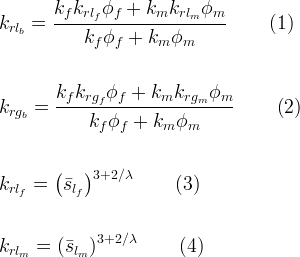
| Symbols | |
 |
bulk aqueous relative permeability |
 |
bulk gas relative permeability |
 |
intrinsic permeability of the fracture material, m2 |
 |
intrinsic permeability of the matrix material, m2 |
 |
aqueous relative permeability of the fracture material |
 |
aqueous relative permeability of the matrix material |
 |
gas relative permeability of the fracture material |
 |
gas relative permeability of the matrix material |
 |
effective aqueous liquid saturation of the fracture material |
 |
effective aqueous liquid saturation of the matrix material |
 |
diffusive porosity of the fracture material |
 |
diffusive porosity of the matrix material |
 |
Brooks and Corey parameter |
Burdine, NT. 1953. "Relative Permeability Calculation from Size Distribution Data," Trans. AIME, 198:71-78.
Corey, AT. 1977. Mechanics of Heterogeneous Fluids in Porous Media, Fort Collins, Colorado.
Fatt , I and WA Klikoff Jr. 1959. "Effect of Fractional Wettability on Multiphase Flow through Porous Media," AIME Trans, 215:426-429.
Gardner, WR. 1958. "Some Steady-State Solutions of the Unsaturated Moisture Flow Equation with Applications to Evaporation from a Water Table," Soil Science, 85:228-232.
Haverkamp, R, M Vauclin, J Touma, PJ Wierenga, and G Vachaud. 1977. "A Comparison of Numerical Simulation Models for One-Dimensional Infiltration," Soil Sci. Soc. Am. J., 41:285-294.
Klavetter, E.A., Peters, R.R., 1986. Estimation of hydrologic properties of unsaturated fractured rock mass. Sandia National Laboratories, Albuquerque, NM.
Mualem, Y. 1976. "A New Model for Predicting the Hydraulic Conductivity of Unsaturated Porous Media," Water Resources Research, 12:513-522.
Nitao, J.J., 1988. Numerical modeling of the thermal and hydrological environment around a nuclear waste package using the equivalent continuum approximation: horizontal emplacement. Lawrence Livermore National Laboratory, Livermore, CA.
Polmann, DJ. 1990. "Application of Stochastic Methods to Transient Flow and Transport in Heterogeneous Unsaturated Soils," PhD, Massachusetts Institute of Technology, Cambridge, MA.
Touma, J. & Vauclin, M. 1986. Experimental and numerical analysis of two-phase infiltration in a partially saturated soil. Trans. Porous Media, 1, 27-55